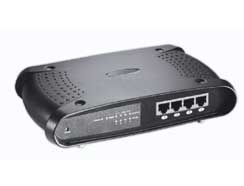Author: Joseph Moran
Review Date: 8/6/2002

Model Number: SS2614 ($99)
The $99 SpeedStream 2614 has everything you need in a broadband router, and then some. In this case, the “and then some” consists of a built-in print server and a serial port to be used for modem backup. These are two immensely useful features, and I wish all routers included them.
Pros:
- Print Server
- Modem Backup
Cons:
- Rudimentary logging
- No e-mail alerts
Basic Features
The unit’s more run-of the mill features include four switched 10/100 ports, DHCP server, DMZ, virtual servers, special application support, client filtering and a firewall feature.
The 2614 chassis is made of sturdy black plastic. My one complaint is that the LAN ports are on the front of the unit, which makes cable management more difficult. However, this was necessary in order to keep the unit svelte while still accommodating the parallel and serial ports.
Documentation (which you probably won’t need, incidentally) and the printer driver are included on a CD. SpeedStream includes a one-year warranty, which they’ll promptly double if you register the product with them.
Setup and Installation
The SpeedStream’s Web-based administration console is extremely clean and simple. All router configuration functions are organized under four main pages. Navigating from page to page is quick, with none of the delay sometimes found in some router control panels.
You start by running Simple Setup, which prompts you for all the requisite information to get the 2614 up and running with your broadband connection. The unit supports four WAN schemes; dynamic address, static address, PPPoE, and dial-on-demand routing. You can configure the dial-up to automatically kick in should the broadband connection go down. We had no difficulty getting the 2614 to work correctly with our Road Runner cable modem connection.
Naturally, the 2614 can function as a DHCP server, and you can adjust the lease time, choosing from nine pre-defined increments, ranging from a half-hour to forever.
The 2614’s status page offers a one-glance view at a variety of important information, including the status of the Internet connection, whether or not various router features are enabled, and even such minutiae as the firmware version and the number of clients connected.
The status page is also where you can view the two router logs; one for security and one for DHCP clients. The information, particularly for security, has limited usefulness as presented. The security log has a tendency to fill up with DHCP DISCOVERs, making it tough to locate entries that may indicate legitimate security concerns.
Moreover, the 2614 does not send e-mail mail security alerts. As a result, the only way you’ll know about an attempted unauthorized access is by manually fishing through the logs on a regular basis. You can, at least, save the logs to the desktop as a text file.
You can set up router access from a remote IP address. I also liked the fact that you can reset the router to factory defaults through software, saving the trouble of having to perform procedures like holding down a reset button while power cycling the unit.
Access Control and Security
The 2614 lets you control client access to network services. You can restrict access (based on IP address) and specify traffic types and port ranges. A nice touch is the ability to restrict access based on day and time (in increments of one hour).
The firewall doesn’t offer any user-configurable parameters; you simply enable it or not. It is pre-configured to detect and prevent a variety of common IP attacks. I’d prefer a little more control, but I did not find any apparent weaknesses when exposing the router to various online port scanners.
Summary
Start with the SpeedStream 2614’s ease of setup, clean interface, and features as modem backup and print server, and you’re well advised to consider the 2614 for use in a home or home office environment, especially at a rock-bottom price of $99.




